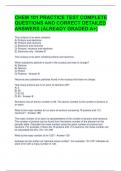Exam (elaborations)
CHEM 101 PRACTICE TEST COMPLETE QUESTIONS AND CORRECT DETAILED ANSWERS (ALREADY GRADED A+)
- Course
- Institution
CHEM 101 PRACTICE TEST COMPLETE QUESTIONS AND CORRECT DETAILED ANSWERS (ALREADY GRADED A+) The nucleus of an atom contains: A) Protons and electrons B) Protons and neutrons C) Electrons and neutrons D) Protons, neutrons and electrons E) Electrons only - Answer-B The nucleus of an atom cont...
[Show more]



